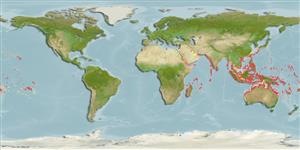Common names from other countries
Classification / Names / Names
Common names | Synonyms | Catalog of Fishes (gen., sp.) | ITIS | CoL | WoRMS
Environment: milieu / climate zone / depth range / distribution range
Ecology
Reef-associated; depth range 3 - 30 m (Ref. 8294). Tropical; 36°N - 34°S, 26°E - 137°W (Ref. 848)
Indo-Pacific.
Length at first maturity / Size / Weight / Age
Maturity: Lm ? range ? - ? cm Max length : 100.0 cm COLD male/unsexed; (Ref. 269)
This is the most commonly of several massive (mound-forming) species with a surface that resembles the maze-like pattern of a mammal brain. The valleys are typically 2 to 3 cm long and 0.5 to 0.6 cm wide. Colonies commonly grow to 1 m diameter or more and are found at all depths (Ref. 269).
Maximum depth from Ref. 98471.
Life cycle and mating behavior
Maturity | Reproduction | Spawning | Eggs | Fecundity | Larvae
Hermaphroditic (Ref. 113712). Mature gametes are shed into the coelenteron and spawned through the mouth. Life cycle: The zygote develops into a planktonic planula larva. Metamorphosis begins with early morphogenesis of tentacles, septa and pharynx before larval settlement on the aboral end (Ref. 833).
Hodgson, G. 1998. (Ref. 269)
IUCN Red List Status (Ref. 130435: Version 2024-1)
CITES status (Ref. 108899)
Not Evaluated
Human uses
| FishSource |
Tools
Internet sources
Estimates based on models
Preferred temperature
(Ref.
115969): 24.7 - 29.3, mean 28.4 (based on 3473 cells).
Vulnerability
High vulnerability (60 of 100).
Price category
Unknown.
